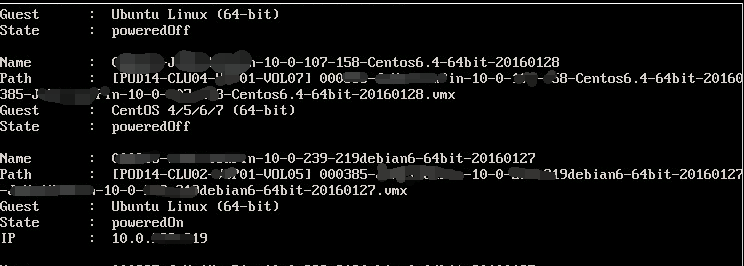pyvmomi 实现VMware自动化 推荐
2016-02-15 14:28
519 查看
运维离不开自动化,python的发展更是给自动化注入了一剂兴奋剂;还记得当时公司年会,大家都在嗨皮,苦逼的运维攻城狮还在卖力的给一个大客户手动开通500台云主机的情形,现在想想好傻O(∩_∩)O哈哈~。如果早点接触pyVmomi,就不至于这么苦逼了。
pyVmomi is the Python SDK for the VMware vSphere API that allows you to manage ESX, ESXi, and vCenter.官方如是说。自己这里写篇博客整理一下,也希望对还停留在手工时代的同学有所帮助。
坏境配置:
1、网络环境:
安装pyvmomi的server和VMware vCenter 网络打通;
2、系统环境:
pyvmomi用pip安装,所以需要有python和pip;pyvmomi 6.0.0需要的python版本支持为2.7, 3.3 和 3.4, 支持的vSphere 版本为:6.0, 5.5, 5.1 和 5.0。
安装如下:
pyVmomi is the Python SDK for the VMware vSphere API that allows you to manage ESX, ESXi, and vCenter.官方如是说。自己这里写篇博客整理一下,也希望对还停留在手工时代的同学有所帮助。
坏境配置:
1、网络环境:
安装pyvmomi的server和VMware vCenter 网络打通;
2、系统环境:
pyvmomi用pip安装,所以需要有python和pip;pyvmomi 6.0.0需要的python版本支持为2.7, 3.3 和 3.4, 支持的vSphere 版本为:6.0, 5.5, 5.1 和 5.0。
安装如下:
$sudo apt-get install python-pip $sudo pip install pyvmomi $sudo pip freeze | grep pyvmomi #查看安装的pyvmomi版本,现在是6.0版本 pyvmomi==6.0.0 #如果已经安装过,升级用pip install --upgrade pyvmomi或者也可以下载源码包安装,https://github.com/vmware/pyvmomi.git:
$sudo python setup.py install3、pyvmomi提供了一些社区样本项目,可以参考编写自己的代码:
git clone https://github.com/vmware/pyvmomi-community-samples.git[/code]4、下面是 pyvmomi给出的获取所有vm的脚本:#!/usr/bin/env python # VMware vSphere Python SDK # Copyright (c) 2008-2015 VMware, Inc. All Rights Reserved. # # Licensed under the Apache License, Version 2.0 (the "License"); # you may not use this file except in compliance with the License. # You may obtain a copy of the License at # # http://www.apache.org/licenses/LICENSE-2.0 # # Unless required by applicable law or agreed to in writing, software # distributed under the License is distributed on an "AS IS" BASIS, # WITHOUT WARRANTIES OR CONDITIONS OF ANY KIND, either express or implied. # See the License for the specific language governing permissions and # limitations under the License. """ Python program for listing the vms on an ESX / vCenter host """ from __future__ import print_function from pyVim.connect import SmartConnect, Disconnect import argparse import atexit import getpass import ssl def GetArgs(): """ Supports the command-line arguments listed below. """ parser = argparse.ArgumentParser( description='Process args for retrieving all the Virtual Machines') parser.add_argument('-s', '--host', required=True, action='store', help='Remote host to connect to') parser.add_argument('-o', '--port', type=int, default=443, action='store', help='Port to connect on') parser.add_argument('-u', '--user', required=True, action='store', help='User name to use when connecting to host') parser.add_argument('-p', '--password', required=False, action='store', help='Password to use when connecting to host') args = parser.parse_args() return args def PrintVmInfo(vm, depth=1): """ Print information for a particular virtual machine or recurse into a folder with depth protection """ maxdepth = 10 # if this is a group it will have children. if it does, recurse into them # and then return if hasattr(vm, 'childEntity'): if depth > maxdepth: return vmList = vm.childEntity for c in vmList: PrintVmInfo(c, depth+1) return summary = vm.summary print("Name : ", summary.config.name) print("Path : ", summary.config.vmPathName) print("Guest : ", summary.config.guestFullName) annotation = summary.config.annotation if annotation != None and annotation != "": print("Annotation : ", annotation) print("State : ", summary.runtime.powerState) if summary.guest != None: ip = summary.guest.ipAddress if ip != None and ip != "": print("IP : ", ip) if summary.runtime.question != None: print("Question : ", summary.runtime.question.text) print("") def main(): """ Simple command-line program for listing the virtual machines on a system. """ args = GetArgs() if args.password: password = args.password else: password = getpass.getpass(prompt='Enter password for host %s and ' 'user %s: ' % (args.host,args.user)) context = ssl.SSLContext(ssl.PROTOCOL_TLSv1) context.verify_mode = ssl.CERT_NONE si = SmartConnect(host=args.host, user=args.user, pwd=password, port=int(args.port), sslContext=context) if not si: print("Could not connect to the specified host using specified " "username and password") return -1 atexit.register(Disconnect, si) content = si.RetrieveContent() for child in content.rootFolder.childEntity: if hasattr(child, 'vmFolder'): datacenter = child vmFolder = datacenter.vmFolder vmList = vmFolder.childEntity for vm in vmList: PrintVmInfo(vm) return 0 # Start program if __name__ == "__main__": main()5、执行之后输出格式如下:
参考资料:
http://vmware.github.io/pyvmomi-community-samples/#getting-started
https://github.com/vmware/pyvmomi
https://pypi.python.org/pypi/pyvmomi
相关文章推荐
- Python动态类型的学习---引用的理解
- Python3写爬虫(四)多线程实现数据爬取
- 垃圾邮件过滤器 python简单实现
- 下载并遍历 names.txt 文件,输出长度最长的回文人名。
- install and upgrade scrapy
- Scrapy的架构介绍
- Centos6 编译安装Python
- 使用Python生成Excel格式的图片
- 让Python文件也可以当bat文件运行
- [Python]推算数独
- Python中zip()函数用法举例
- Python中map()函数浅析
- Python将excel导入到mysql中
- Python在CAM软件Genesis2000中的应用
- 使用Shiboken为C++和Qt库创建Python绑定
- FREEBASIC 编译可被python调用的dll函数示例
- Python 七步捉虫法

